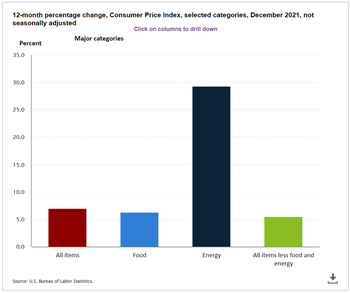<p>By Andy Harig, Vice President, Tax, Trade, Sustainability & Policy Development, FMI</p>
<img src=”https://www.fmi.org/images/default-source/blog-images/december_cpi_chart-011322.tmb-large-350-.png?sfvrsn=d2297659_1″ data-displaymode=”Thumbnail” alt=”December CPI Chart” title=”December_CPI_Chart-011322″ style=”float: right; margin: 10px;” />
<p>A food retailer once told me that they could give as good of a read on the American economy as any top economist just by looking at their store shelves. If that is true, then that grocer would be able to tell you that heading into 2022 consumer demand is soaring and the supply chain is struggling to keep up. And as the just-released December Consumer Price Index showed, it is continuing to result in higher food prices while forcing food retailers to take every step possible to keep costs as low as they can for shoppers.</p>
<p>Of course, 2022 was not supposed to begin this way. When I attended <a href=”https://www.fmi.org/blog/view/fmi-blog/2021/03/15/the-ups-and-downs-of-food-prices”>last February’s</a> USDA Agriculture Outlook, the agency predicted that food prices would stabilize and return to a more traditional rate of growth of between one and two percent. It made sense at the time, because things were looking up a year ago: <a href=”https://www.cnbc.com/2021/02/16/biden-administration-increases-weekly-covid-vaccine-shipments-to-states-and-pharmacies-.html”>vaccines</a> were becoming widely available, local governments were beginning to reopen <a href=”https://ny.eater.com/2021/2/8/22272476/indoor-dining-nyc-friday-february-12-restart-cuomo”>indoor dining</a>, and <a href=”https://www.usatoday.com/story/opinion/2021/02/26/covid-19-vaccines-herd-immunity-pandemic-could-be-ending-column/6810858002/”>headlines predicted</a> that the end of the COVID-19 pandemic was in sight.</p>
<p>Unfortunately, despite this optimism, a variety of unpredicted factors have since resulted in elevated food prices and strained supply chains.</p>
<p>New and more contagious variants of the coronavirus continue to keep Americans away from restaurants, increasing average household spending on food to <a href=”https://www.usatoday.com/story/money/shopping/2021/10/13/food-shopping-prices-up-cpi-september-2021-saving-tips/6035703001/#:~:text=According%20to%20a%20recent%20survey,March%20and%20April%20of%202020.”>$143</a> per week from the average pre-pandemic amount of $113.50. <a href=”https://www.grocerydive.com/news/fmi-80-of-food-retailers-say-hiring-issues-are-hurting-business/606695/”>Labor shortages</a> — as a result of limited childcare options, pandemic-related safety concerns, vaccine mandates, and the rise of the gig economy — have made it difficult for the food industry to attract and retain employees and have caused delays and bottlenecks across the supply chain. And unpredictable weather patterns throughout 2021 – from <a href=”https://www.nytimes.com/article/drought-california-western-united-states.html”>droughts</a> to <a href=”https://www.usatoday.com/story/news/nation/2021/11/30/2021-hurricane-season-ends-lots-storms-slow-finish/8769723002/”>tropical storms</a> – have increased the cost of raw materials and added figurative and literal roadblocks to getting goods to grocers’ shelves.</p>
<p>These challenges are not unique to the food industry. According to the December CPI, inflation has hit every corner of the U.S. economy, from steaks to SUVs. And while these cost increases are nearly universal, higher food prices are acutely painful for families. While we may only need to buy a car every 15 years or so, we need to eat every day. And it is incumbent on the food industry to give consumers the tools and information they need to extend their grocery dollars as far as possible. Food retailers can leverage FMI’s suite of user-friendly <a href=”https://spaces.hightail.com/space/73dIOdQKhm/files”>infographics</a> and <a href=”https://www.fmi.org/foodprices”>interactive guide</a> on the fundamentals of food prices to help explain the complex web of global supply chain challenges and how they impact the price and availability of grocery staples.</p>
<p>It is easy to become discouraged and exhausted by another year of supply chain woes, but our industry — and our customers — have been resilient and resourceful. The road ahead in 2022 is sure to be tough, but new challenges create new opportunities. Food retailers are <a href=”https://www.fmi.org/our-research/research-reports/food-retailing-industry-speaks”>innovating</a> more than ever before. From data analytics to artificial intelligence, and robots to micro-fulfillment centers, technology is increasingly front and center in food retail to improve the customer experience and boost operational efficiencies to patch the vulnerabilities identified throughout the pandemic.</p>
<p>If the last year taught us anything, it is that our communities depend on us for more than just food – we are local health centers, vaccination hubs, and so much more. Still, in 2022, the food industry will continue stepping up for their communities by adapting, pivoting, and innovating to keep shelves stocked at the most affordable price point, as it has since day one of this pandemic.</p>
Jan 13, 2022
By Andy Harig, Vice President, Tax, Trade, Sustainability & Policy Development, FMI
A food retailer once told me that they could give as good of a read on the American economy as any top economist just by looking at their store shelves. If that is true, then that grocer would be able to tell you that heading into 2022 consumer demand is soaring and the supply chain is struggling to keep up. And as the just-released December Consumer Price Index showed, it is continuing to result in higher food prices while forcing food retailers to take every step possible to keep costs as low as they can for shoppers.
Of course, 2022 was not supposed to begin this way. When I attended last February’s USDA Agriculture Outlook, the agency predicted that food prices would stabilize and return to a more traditional rate of growth of between one and two percent. It made sense at the time, because things were looking up a year ago: vaccines were becoming widely available, local governments were beginning to reopen indoor dining, and headlines predicted that the end of the COVID-19 pandemic was in sight.
Unfortunately, despite this optimism, a variety of unpredicted factors have since resulted in elevated food prices and strained supply chains.
New and more contagious variants of the coronavirus continue to keep Americans away from restaurants, increasing average household spending on food to $143 per week from the average pre-pandemic amount of $113.50. Labor shortages — as a result of limited childcare options, pandemic-related safety concerns, vaccine mandates, and the rise of the gig economy — have made it difficult for the food industry to attract and retain employees and have caused delays and bottlenecks across the supply chain. And unpredictable weather patterns throughout 2021 – from droughts to tropical storms – have increased the cost of raw materials and added figurative and literal roadblocks to getting goods to grocers’ shelves.
These challenges are not unique to the food industry. According to the December CPI, inflation has hit every corner of the U.S. economy, from steaks to SUVs. And while these cost increases are nearly universal, higher food prices are acutely painful for families. While we may only need to buy a car every 15 years or so, we need to eat every day. And it is incumbent on the food industry to give consumers the tools and information they need to extend their grocery dollars as far as possible. Food retailers can leverage FMI’s suite of user-friendly infographics and interactive guide on the fundamentals of food prices to help explain the complex web of global supply chain challenges and how they impact the price and availability of grocery staples.
It is easy to become discouraged and exhausted by another year of supply chain woes, but our industry — and our customers — have been resilient and resourceful. The road ahead in 2022 is sure to be tough, but new challenges create new opportunities. Food retailers are innovating more than ever before. From data analytics to artificial intelligence, and robots to micro-fulfillment centers, technology is increasingly front and center in food retail to improve the customer experience and boost operational efficiencies to patch the vulnerabilities identified throughout the pandemic.
If the last year taught us anything, it is that our communities depend on us for more than just food – we are local health centers, vaccination hubs, and so much more. Still, in 2022, the food industry will continue stepping up for their communities by adapting, pivoting, and innovating to keep shelves stocked at the most affordable price point, as it has since day one of this pandemic.




